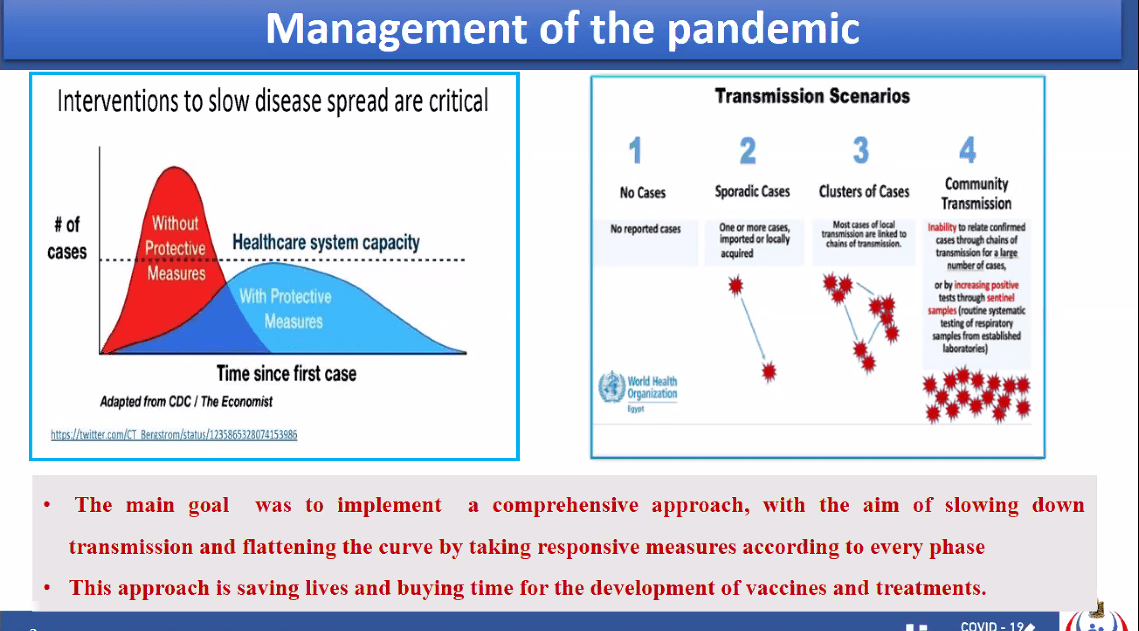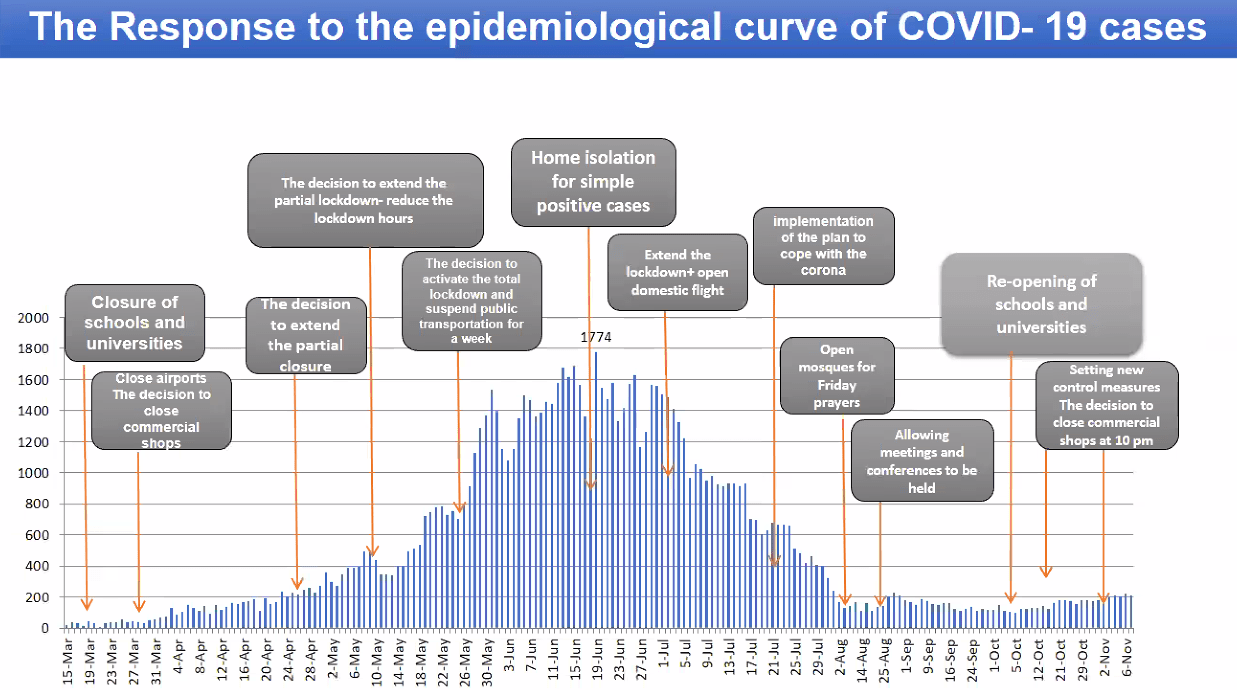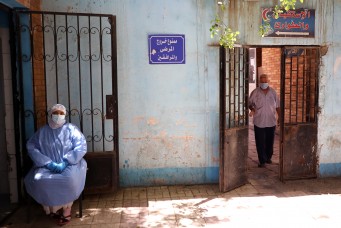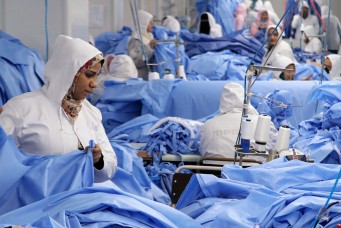COVID-19 in Egypt: Between Governance and Flattening the Curve
Egypt’s Minister of Health and Population (MoHP) Dr. Hala Zayed speaks about managing the COVID-19 pandemic and what economic and health policies the country has taken to ensure public safety.

Egypt is now bearing the brunt of the second wave of the COVID-19 novel coronavirus, Egypt’s Minister of Health and Population (MoHP) Dr. Hala Zayed has publicly said.
COVID-19 began to spread as a contagious virus in China in December 2019 and was eventually declared a global pandemic by the World Health Organization (WHO) in March 2020. Ever since, Egypt has implemented a number of measures which helped to curb the spread locally. Numbers of COVID-19 cases peaked in June 2020, only to recede in the months since then.
But the number of cases have started to rise again. According to figures released from the Ministry of Health, the number of new cases a day has now reached 342, up from just under 100 a month ago.
“This is the pandemic era and everything is changing. We need to be realistic in our decisions. We need to change our mindsets to be able to manage and proceed,” Zayed said in her opening remark during a recent Global Affairs and Public Policy (GAPP) Tahrir Dialogue special webinar series.
Countries around the world are now working to curb the spread of the virus by implementing total and partial lockdowns, enforcing mask-wearing, encouraging working from home and online education, and racing to produce vaccines and establish set treatment methods.
Zayed likened the pandemic to a sudden exam that began in January which caught the whole world without preparation, curriculum or specific guidelines.
“We had to follow new thinking styles because the decisions we take have everlasting impacts, such as the decision to fully lock down,” said Zayed.
Egypt & Pandemic Management
In such unexpected global crises, the main aim is to set national health targets so that all stakeholders can look into the situation accordingly in a systematic, unified way. Since this is multidimensional and multi-sectoral, the government is responsible for overall management. Seeing as this is a high-level management issue, decisions are based on several pillars that include both health and socioeconomic issues.

Zayed said that there are two curves for the pandemic depending on what each country chooses to do. In countries that followed the red curve (as shown above) the peak began a few weeks after the first reported COVID-19 cases.
In Egypt, however, the peak was in June. “It took us five or six months to be able to continue flattening. We followed the blue curve. The maximum was 1,900 cases per day during the peak of Wave 1 compared to the five or six thousand daily cases in other European countries,” said Zayed.
“Our aim was always to flatten the curve.”
Every country went through different stages of contagion, or ‘transmission scenarios,’ going from having no reported cases, to sporadic cases, to clusters of cases. Right now, the world has reached a stage of the pandemic called “community transmission” where it has become difficult to trace the chain of transmission, as the number of confirmed cases is too high.
In Egypt, decisions were based on infectious status, community engagement and on public health capacity. In regards to the latter, Zayed said that there is surveillance capacity, quarantine capacity for people coming in from airports and any points of entry, sanitation capacity, and an adequate health care system with hospitals, labs and testing centers.
Managing a global health pandemic is largely about taking decisions at the right time.
The minister explained that decisions taken at the right time need to be consistent with the infection status and with socioeconomic issues. Throughout Egypt’s management of the pandemic, the government and leadership were centrally and sub-nationally involved in health sector issues. Moreover, because health issues impact other sectors in the country, there is multi-stakeholder coordination on the national level in various sectors including, but not limited to, tourism, economy, gender, agriculture, infrastructure, etc.
In the meantime, Egypt was also heavily focused on continuous monitoring and evaluation of the efficacy of the taken measures. Funding the health sector also played a major role in moving forward.
“The fund is not only for healthcare, but also to support the economy. The country allocated over a hundred billion EGP (6.4 billion USD) to respond to the crisis. We used 5 to 6 billion in the healthcare sector,” said Zayed.
Equally necessary is spreading public awareness about wearing masks and social distancing.
In a recent cabinet meeting, Egyptian Prime Minister Mostafa Madbouly said that citizens who do not wear masks in public and crowded places will face fines. Government officials have stressed that if the public does not adhere to precautionary measures, the country may have to take difficult decisions which could harm the economy.
“Since the beginning of the pandemic, a package of precautionary measures have been taken, which in turn led to flattening the curve of infections and gave the health system an opportunity to absorb the numbers so that they do not suddenly increase and lead to the collapse of the health system as has happened in some countries,” explained Zayed.
A Timeline of Infection
In Egypt, the first COVID-19 case appeared in late February/ early March, leading to the closure of schools and universities by mid-March and the closure of airports and commercial shops by the end of March.

At all times, Zayed explained, health services were at a maximum capacity of operation so as to handle the growing number of cases. At the outbreak of the pandemic in Egypt, all cases were generally isolated in hospitals.
Zayed said that there were nine hospitals, fifty triage hospitals and twenty seven labs alongside four hundred and forty ambulances allocated to manage the crisis in February and March.
“We discovered that not all cases need to be hospitalized. 85 percent of the cases are mild to moderate. Those are isolated in hotels and dorms with complete medical care,” she said. Zayed added that the MoHP collaborated with businessmen and the Ministry of Higher Education to free up space for patients in hotels and in student dorms.
By June, the MoHP decided that people with mild to moderate symptoms could also isolate in their own homes. At that time, there was a massive increase in the number of hospitals to over three hundred and forty, alongside an increase in the number of active labs and ambulances.
“After a decrease in the number of recorded cases, we downsized the number of beds and are operating with twenty one isolation hospitals. We expand and respond according to what governorates need and as per the situation,” said Zayed.
She added that over 85 percent of the cases are isolated at home under complete medical supervision from the ministry.
“This is how to be resilient and flexible in being able to respond to a situation without collapsing the healthcare system… If we isolate everyone in the hospital, the health care system can collapse,” she said.
This way, any critical cases that need hospitalization will receive proper attention and care.
Some Egyptians were abroad and unable to return home, in response to which, “when the first case was reported in Wuhan, China, we began to evacuate Egyptians,” she said. When travel was reopened in July, the Egyptian Cabinet decided that everyone returning from abroad would need to present a negative PCR test to enter the country.
Complete Lockdown vs. Partial Lockdown
“We never did a complete lockdown in Egypt,” said Zayed. This happens to be one of the most crucial decisions that the government took.
A total lockdown in Egypt would have had severe economic consequences, as the informal sector accounts for 70 or 80% of the country’s economy.
People working in the informal sector do not have set working hours or a set monthly income, they are generally paid per day. Hence, a total lockdown would not have been sufficient.
“Based on our experience, we work to flatten the curve with two sets of measures: mass testing vs target testing and total lockdown vs partial lockdown… Egypt and Japan decided to do target testing instead of doing PCR for everyone. We do PCR for people who have symptoms of infection. But in Spain, Italy, UK and France, there was mass testing,” said Zayed.

The minister added that the above European countries also decided to go into complete lockdown, and occasional partial lockdown depending on the scenario at hand.
“After 10 months of our experience, the total test per million in all European countries is about 88 million with more than 5 million positive cases and over 170 thousand deaths,” said Zayed. In Egypt and Japan, the total number of tests was at about 24 million where 216 thousand tested positive alongside 8 thousand deaths.
Europe, a high-income, economically developed region, has not had to handle a pandemic in over a hundred years, said the minister. Hence, middle-income countries might actually be doing better as they have more experience dealing with health pandemics.
Governance During COVID-19
In Egypt, there is a strong surveillance activity system in place because the country has previously had to manage infectious diseases. The country established a dynamic map that is updated every 10 minutes to show reported cases and where the clusters of infected people are located.

“Pandemic is not a healthcare issue, it is a government issue. Governance and leadership is important especially in empowering people and letting them trust you, and to unify everyone under several targets,” said Zayed.
Egypt has previously had to eliminate Virus C, a liver disease caused by the hepatitis C virus, an experience from which the country has drawn lessons for the fight against COVID-19, the minister explained. She said that the same health directors who worked on Virus C are also working on managing the pandemic.
“The minister assistant for public health issues who eliminated Virus C is the same person who headed the pandemic management,” she said.
While the country works to combat the virus, there are still other pressing medical issues that need not be ignored.
“We did not close our hospitals in the face of different healthcare issues,” said Zayed. Many countries have ensured that hospitals are focused on treating only COVID-19 while cancer patients or those suffering from heart problems remain on the sideline.
A CNN article titled “As hospitals focus on coronavirus, patients with other illnesses wait in fear”, reports that some hospitals abroad are so focused on COVID-19 that patients with other illnesses are ignored.
“For some, services they relied on are no longer available or have been canceled. For others, the services they need are still available, but they’re too scared to venture out and risk contracting the virus,” writes CNN.
“COVID-19 revealed the importance of protecting vulnerable populations,” said Zayed.
Mohamed Salma, Visiting Associate Professor at the School of Sciences & Engineering (SSE) at AUC, agrees that while curing COVID-19 is crucial, this was an opportunity to understand the health sector.
“As physicians, we are focused on treatment and diagnosis, however now, we learn that there are other things that can shape the issue such as socioeconomic situations, mental health, and the environment,” said Salama.
The Second Wave and Multilateralism
“The pandemic has no borders and no one is safe until everyone is safe,” said Zayed.
France, the United Kingdom, and other countries have recently been enforcing lockdowns again due to the ‘second wave’. Inevitably, no country is safe without the protection of other countries.
Zayed visited both China and Italy during critical times to receive assistance for Egypt and to offer assistance to other countries.
“We supported more than 30 countries in Africa under the pandemic fund. Egypt supported with more than 4 million USD in supplies of medicine,” she said, adding that support was also given to a lot of Arab countries such as Lebanon.
Egypt is well prepared for the possibility of a second wave, in terms of human resources; vaccines; hotlines for immediate access to MoHP; developing a network of laboratories; enhanced medical infrastructure, supplies, and treatment protocols.
“Health officials have assured the public that Egypt will be among the first countries to get the Pfizer vaccine once it is fully approved,” writes Ahram Online. Pfizer, a U.S. multinational pharmaceutical company, in collaboration with Germany’s BioNTech, announced that their vaccine is over 90% effective in preventing the virus.
Responding to COVID-19 requires both a multi-sectoral response on the national level, and a multilateral response globally. Within the country, various ministries supported the pandemic response. For instance, Zayed explained that the Ministry of Endowments prohibited holding funerals or marriage contracts in mosques and cancelled Friday sermons for prayers. Moreover, the Ministry of Tourism, which suffered greatly, also had to reform hotels and travel to be safe. The Ministry of Education also had to adapt to online learning and re-model curriculum to fit hybrid teaching with their reopening in October.
“The main aim is to set national health targets so all stakeholders can focus and continue work. The management of the system shall be resilient and reactive to the changing needs of the pandemic that affect all the sectors of the government,” said Zayed.
Dania El Akkawi is associate editor at the Cairo Review of Global Affairs.
Read MoreSubscribe to Our Newsletter





